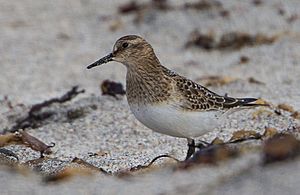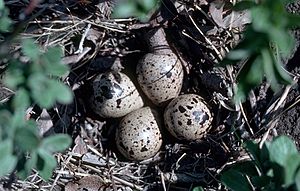Baird's sandpiper facts for kids
Quick facts for kids Baird's sandpiper |
|
|---|---|
 |
|
| In Iceland | |
| Conservation status | |
| Scientific classification | |
| Synonyms | |
|
Actodromas bairdii |
The Baird's sandpiper (Calidris bairdii) is a small shorebird. It's a type of bird that lives near water. These birds were once in a group called Erolia, but they are now part of the Calidris family. The name Calidris comes from an old Greek word for grey waterside birds. The English name and the scientific name bairdii honor Spencer Fullerton Baird. He was a famous naturalist from the 1800s.
What Does It Look Like?
Adult Baird's sandpipers have black legs. They also have a short, straight, and thin dark beak. Their backs are dark brown. Their bellies are mostly white. They have a black patch on their rump (the lower back, above the tail).
Their head and chest are light brown with dark streaks. In winter, these birds look a bit paler. It can be tricky to tell them apart from other tiny shorebirds. These small birds are sometimes called "peeps" or "stints."
One easy way to identify a Baird's sandpiper is its long wings. When the bird is on the ground, its wings reach past its tail. Only the white-rumped sandpiper has wings this long. But you can tell that bird apart by its white rump.
Where Do They Live and What Do They Eat?

Baird's sandpipers make their nests in the northern tundra. This area stretches from eastern Siberia to western Greenland. They build their nests on the ground. They usually choose dry spots with low plants.
These birds are long-distance migrants. This means they travel very far. They spend their winters in South America. Sometimes, a few of these birds might fly off course. They can be seen rarely in western Europe.
Baird's sandpipers look for food on muddy areas near water. They mainly eat insects. They also enjoy small crustaceans, like tiny crabs or shrimp.
- BirdLife species factsheet for Calidris bairdii
- Lua error in Module:EditAtWikidata at line 29: attempt to index field 'wikibase' (a nil value).
- Interactive range map of Calidris bairdii at IUCN Red List maps
- Audio recordings of Baird's sandpiper on Xeno-canto.
- Calidris bairdii in Field Guide: Birds of the World on Flickr
- species name is missing
See also
 In Spanish: Correlimos de Baird para niños
In Spanish: Correlimos de Baird para niños



